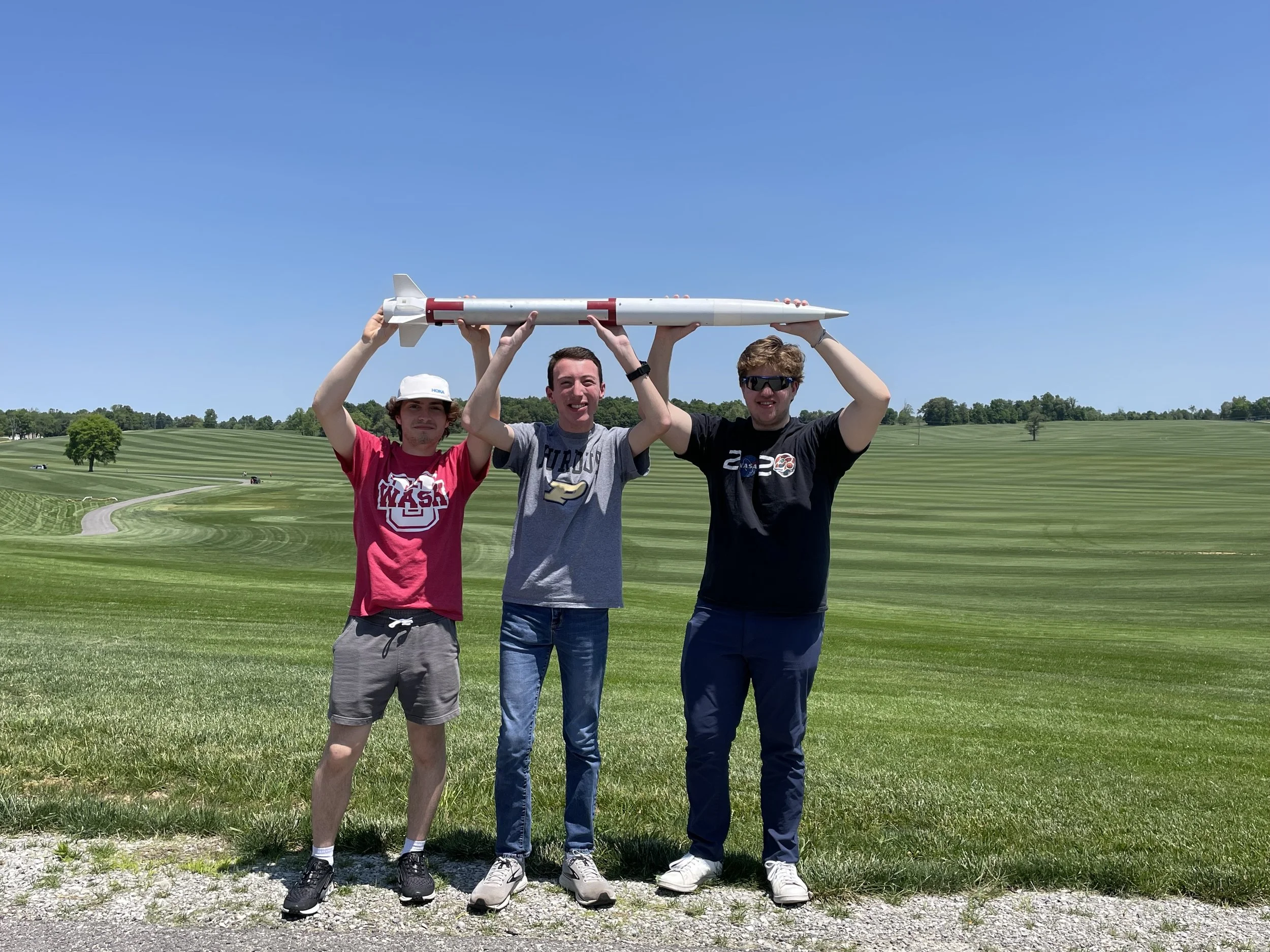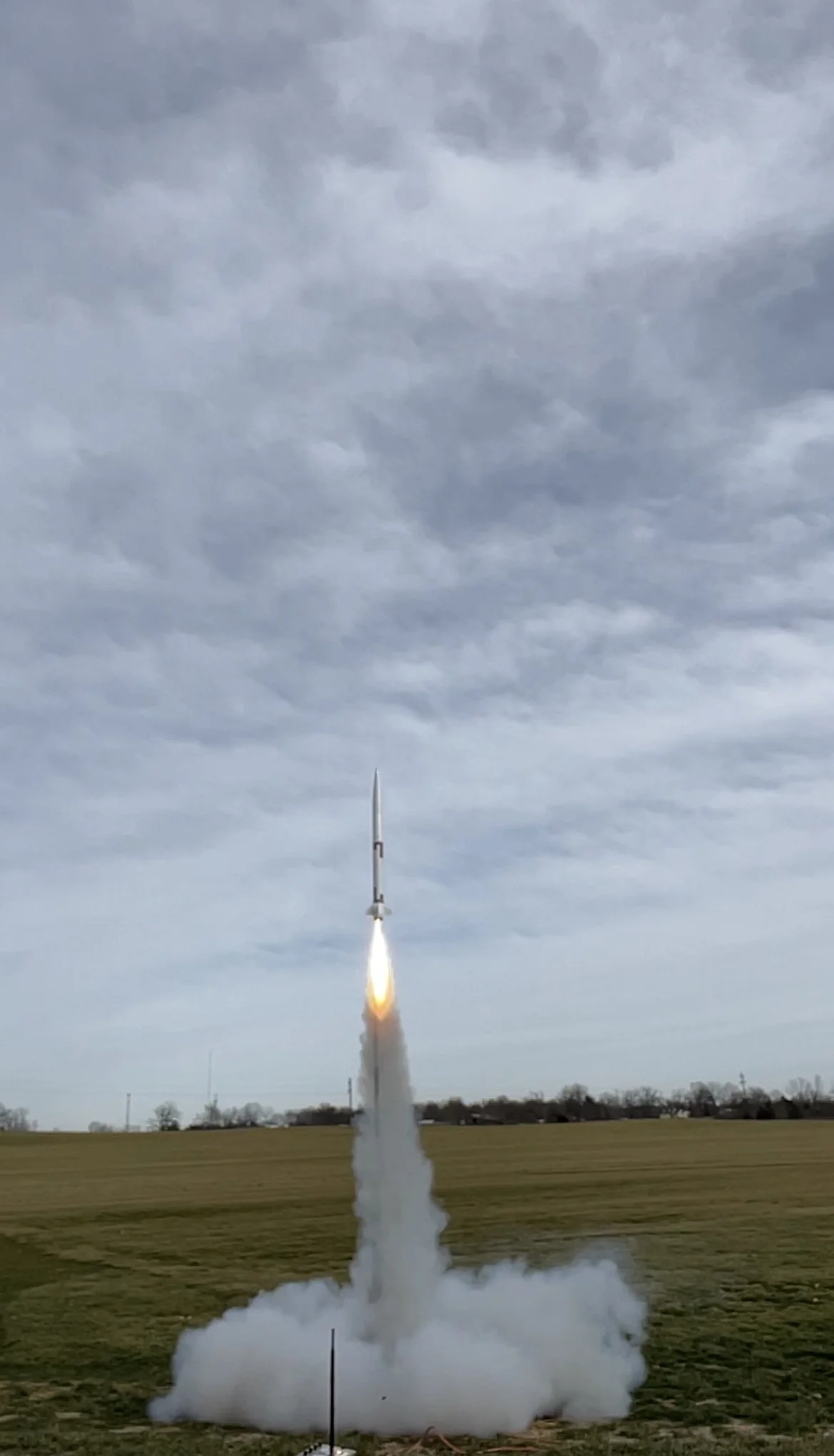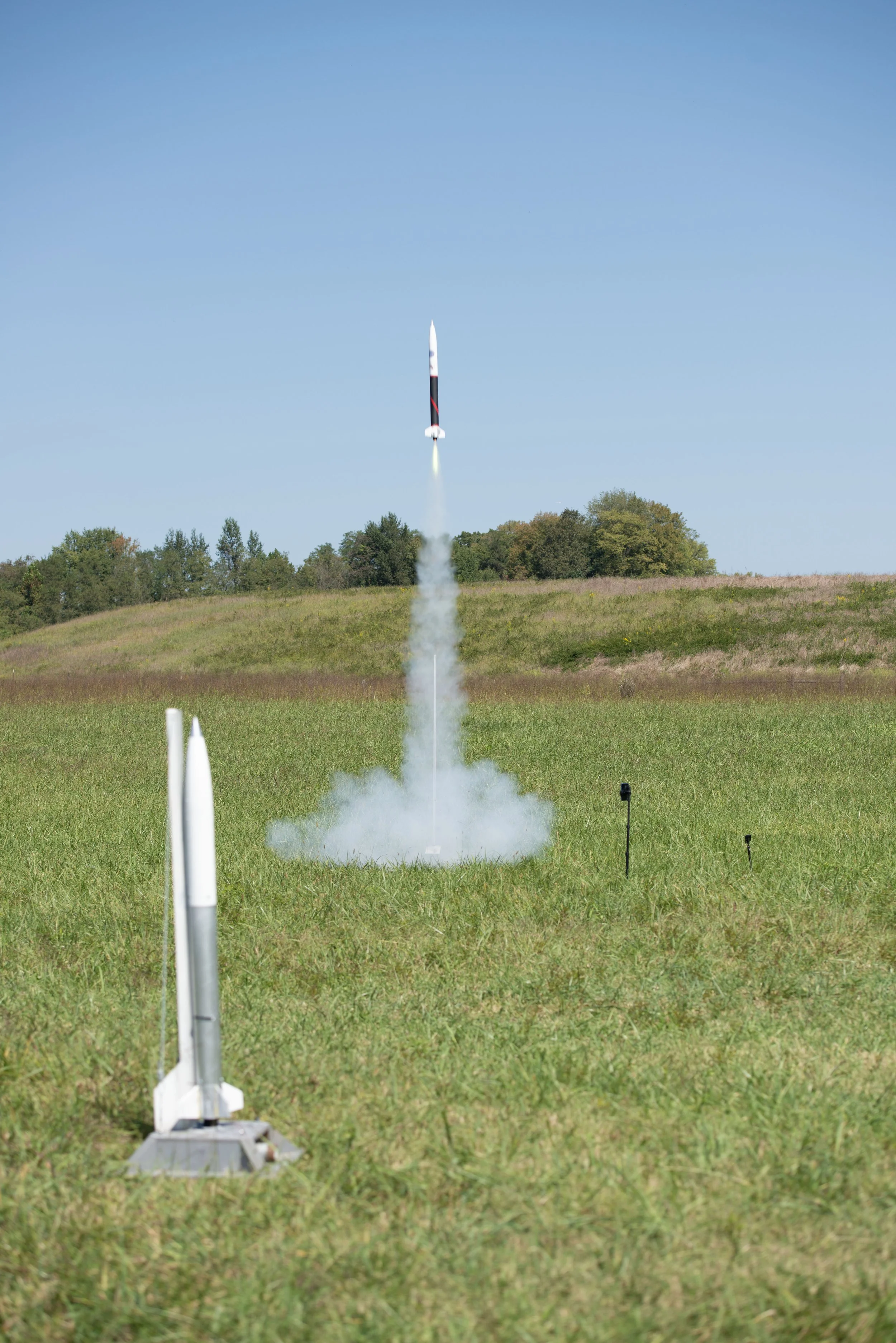Updates
May 12, 2024: Attempting Mach 1
On May 12, I launched Harrier 2A on my first-ever attempt at sending a rocket past Mach 1, 767 mph! This flight also had the secondary objective of earning my Level 2 high power certification, since it was my first flight on a J motor.
After prelaunch preparations assisted by Will Ostroski, Henry Wykoff, and Jan Brackett, I raised Harrier vertical on the pad in Elizabethtown, Kentucky. Once we were ready to launch, Harrier streaked into the sky powered by its Aerotech J435WS motor. Harrier reached apogee very smoothly despite losing its outward-facing camera due to aerodynamic forces. At apogee, the ejection charge deployed the parachute perfectly, but the payload section broke away from the rocket due to its couple shearing off unexpectedly. While the payload landed mostly intact, this unplanned separation disqualified me from earning my L2 certification from this flight. Meanwhile, the booster had a perfect landing after its parachute was unfurled at 400 ft above the ground by its Jolly Logic Chute Release!
Unfortunately, it appears that the payload experienced some sort of glitch either before launch or during the flight that caused it not to record any data from the flight. Because of this, I am unable to confirm whether or not Harrier exceeded Mach 1 during its ascent even though I am confident that it likely did! Harrier 2A was planned to reach Mach 1.09 on this attempt and overshoot the speed of sound by over 69 mph, leading me to think that it likely did reach Mach 1 on this attempt based on Openrocket simulator data. Even though I was not able to accomplish what I wanted to on this flight, I still had a great time launching and hanging out at the Bluegrass Rocketry launch site!
I am ready to launch the next attempt at Mach 1 as soon as July 20 in Olmstead, Kentucky! Even though the academic school year has come to a close, I'm not done with Project 767 just yet!
April 21, 2024: A Day Trip to Mach 0.9
On April 21, I launched Harrier 2A on its second flight! Harrier became the first operational launch from the Music City Missile Club's new launch site in Olmstead, Kentucky. The rocket's I500T motor powered it to a top speed of 317 m/s, which is Mach 0.925! On the way down, Harrier's parachute became stuck inside of its body tube leading to a less-controlled landing than I was hoping for. This also caused one of the fins to be broken during descent because the full 13.5 ft shock cord was not all the way out, leading to the payload section recontacting the booster while the rocket tumbled. The damage from this flight is repairable, however, and I am getting ready to fly again this weekend! The parachute problem can also be solved by mounting it higher on the shock cord so that it comes out immediately.
Weather permitting, I will attempt to launch Harrier 2A next weekend on its first-ever flight past Mach 1! The rocket is currently predicted to exceed Mach 1.1 on a J435WS motor! Since this will be my first flight on a J motor, it will also count as my first attempt at an L2 certification.
April 6, 2024: Sparky Spinning
On Saturday, April 6th, I launched Harrier 2 on its first flight!
While Harrier 2 successfully lifted off the pad, the flight went awry when it began suddenly pitching uncontrollably in different directions. Harrier then reached a maximum altitude of 984 ft (300m) before falling to the ground after the motor's ejection charge failed to deploy the parachute.
After I recovered the rocket, I found with the help of Peter Tarle of Bluegrass Rocketry that the Dark Matter fuel I was using had formed a chunk of metal in the nozzle during the flight that caused it to burn unevenly and point the rocket in the wrong direction. I had never flown with Dark Matter before, so I was unaware of the possibility of it creating metal deposits due to the unburned metal in its exhaust which creates all of the sparks! We found that the likely cause of the ejection charge malfunction was that the gasses exited out of the back of the rocket rather than pressurizing the body tube due to the nozzle being eroded more than usual.
Despite this suboptimal flight, I was able to recover Harrier in a repairable state and am working on getting it ready to fly again in two weeks! This flight also helped prove Steve Ghertner's Version 2 payload. I am working on replacing the nosecone and engine section of the rocket. I am taking the opportunity to upgrade the fins to PETG material, which is less likely to snap under stress than PLA. This will be helpful for high-speed environments where the rocket might experience fin flutter. I am also looking at adding a backup deployment altimeter to the payload that could work as a backup ejection charge in case motor ejection malfunctions again!
March 11, 2024: Get Ready for a Little Jolt!
On Monday, March 11, I took advantage of Spring Break and the beautiful Tennessee weather and did some flight testing!
Since the last flight of Harrier 1, one of the components I decided to upgrade was the shock cord mount. The previous design I used involved just looping and tying the shock cord through the walls of the rocket a couple of times. This design was nice because of its simplicity and little weight, but was somewhat flimsy and usually broke after a few flights. It was also just ugly as well.
The new design involves printing a new centering ring to go around the top of the motor tube that has two eye bolts for the shock cord to attach to. Because this is an important new system, I brought Hermes out of retirement to test it out before I put it on a high-power rocket! Hermes launched on a G67G from Chickasaw Trace Park in Columbia, Tennessee, and the new shock cord mount performed perfectly!
February 24, 2024: Harrier 1 Rises Again!
On Saturday, February 24th, I launched Harrier 1 for the third time! Harrier flew aboard an Aerotech I245G motor to a new personal estimated altitude record of 3953ft! The flight went perfectly and also hit a new estimated personal speed record of Mach 0.6.
This was also my first launch with the Huntsville Area Rocketry Association (HARA). I had a great time and look forward to launching with them in the future! I am hoping to return later in March
The next milestone for Project 767 will be the first flight of Harrier 2! Harrier 2 will use all of the new things I have learned with the successes of Harrier 1 to hit even higher speeds. Flight 1 of Harrier 2 is targeting Mach 0.8 aboard an I280DM motor! This flight also has the possibility of being my first rocket to exceed a mile in altitude. Harrier 2 construction is already well underway with many parts having been printed!
February 4, 2024: Harrier 1 Takes to the Sky!
On Sunday, February 4, Harrier 1 left the the pad for the first time under the power of an Aerotech I140W motor! These flights marked the first high-power launches of Project 767 and were my first using I motors!
The first launch hit a maximum altitude of 854m (2,802ft) and a maximum vertical velocity of 150.8m/s – Mach 0.44!
The second launch reached apogee at 894m (2,933ft) and reached a maximum vertical velocity of 189.9m/s – Mach 0.55! Flight 2 set new personal speed and altitude records!
Both flights carried Steve Ghertner’s instrument unit payload, which recorded acceleration, gyroscope, barometric, and GPS data throughout the entire flight. The GPS was instrumental in recovering Flight 1, because it landed half a mile away.
Flight 2 splashed down in a pond, causing some of the electronics to short out, Harrier 1 is still in good shape though and I look forward to flying it again soon!
September 23, 2023: Launching From Chickasaw!
We had three spectacular launches on Saturday! Despite not being able to go up to Kentucky to fly on high-power motors, we made do with G76G motors and got great data! Our new launch site at Chickasaw Trace Park in Columbia was optimal, as it is close, has a massive field, and we are free to do almost anything we want there. The bright-green-burning G76G motors also provided a good substitute for the H238T motor that we were planning to fly on, as it is just below the power that would be classified as a high-power motor. The G76G’s still got the rockets flying high and fast and provided a perfect environment to test out the ChuteRelease and onboard sensor unit! I am looking forward to applying what I learned from these launches and analyzing the data!






